#LNER 4-8-2
Explore tagged Tumblr posts
Note
Hey Um Hazel
I gotta ask ya, but have you heard of the last engine idea, Sir. Nigel Gresley had?
Evidently, its suppose to be called LNER 4-8-2 "Mountain" Type Locomotives
However he died, before he ever did start on the blueprints.
I have heard of it! 4-8-2 mountains were more common in other places, but they existed in Britian...well on the 15 inch gauge.Meat Hercules and Sampson of the Romney Hythe & Dymchurch Railway. Built in 1927, their Designer Henry Greenly was friends with Sir Nigel Gresley, and many of his engines follow GNR or LNER practice, so these are a good example of how these engines would have felt.


Further, I made a drawing of a LNER Mountain, based on a sketch by Sodor's Safey Record.

11 notes
·
View notes
Text
Bulleid's Proposed Locomotives
So it turns out Bulleid had so many of his designs dropped for one reason or another, and since I can't stick with a single project for more than a few seconds, I wrote up histories for all of them!
Enjoy the ramblings of a madman who spent a good long while finding free number slots for them.
Southern Railway Warship Class
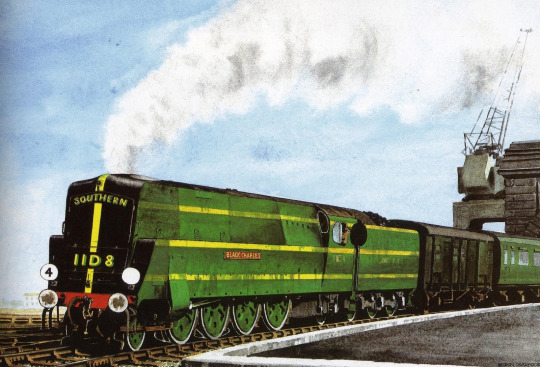
The Southern Railway was the most financially successful of the "Big Four", but this was largely based on investment in suburban and main line electrification. After the successful introduction of the SR Schools class in 1930, the railway had lagged behind the others in terms of modernizing its aging fleet of steam locomotives, as they were more focused on Electrification. Following the retirement of the general manager of the Southern Railway Sir Herbert Walker and Richard Maunsell the Chief Mechanical Engineer (CME) in 1937, their successors considered that the time had come to change this situation. In March 1938 the new general manager Gilbert Szlumper authorized Oliver Bulleid, Maunsell's replacement, to prepare designs for twenty express passenger locomotives. The deteriorating international situation prior to the Second World War was an additional factor in this decision.
Originally, Bulleid had wanted a 4-8-2 Mountain Type, but the Civil Engineering department had resisted this based on size and weight, so a 2-8-2 was chosen instead. Bulleid had worked with Gresley on his P2 2-8-2 express engines, so he already had some background knowledge, especially with the P2’s problems and ideas on how to solve them. Of course, due to the war, they were classified as heavy mixed-traffic engines to get around wartime regulations.
They were built with high-pressure 280 PSI boilers and three 18inx26in cylinders, as well as being the first engines to use Bulleid’s chain-driven valve gear, though the middle cylinder had to be inclined steeply to clear the first driven axle. The boiler was partly welded to save on cost, and the inner firebox was made of steel. The Southern had no facilities to build these boilers, so it was subcontracted to the North British Locomotive Co., as well as Beyer Peacock. They were also fitted with Bulleid’s Air-Smooth Casing. Unlike later designs that utilized this, the casing on the Warships both served their function purpose as labor saving as well as being able to be passed off as some sort of streamlining. How Bulleid got that one through during the war is a mystery! The Warship’s were also the first to use Bulleid’s Firth-Brown Wheels.
10 of these engines were constructed in 1940. More were set to be produced, but once again, the Civil Engineering Department expressed their discomfort at such a large engine running at high speeds with only a single pony-truck in front, despite other engines of a similar design getting on fine elsewhere. This would lead Bulleid to designing and building 30 of his well-known Merchant Navy Class 4-6-2s.
They were named after Warships as a way to increase morale, with 11D1 being officially named “Dreadnought” in April 1940. They performed well in service, hauling heavy passenger and express goods, though the Chain-Driven valve gear was sensitive and required high maintenance, as well as the oil-bath having leaking problems, contributing to wheel-slips(Though the extra wheel helped negate this as well). The casing, while it did save on labor during cleaning, and the more streamlined appearance helped with publicity, it made maintenance hard to carry out. Surprisingly, thanks to their different front ends, they never really experienced drifting smoke like Bulleid’s Pacifics.
All 10 of the engines would be passed into British Railways, numbered 37001-37010, where their duties mostly stayed the same. 11D8 “Black Charles'' took part in the 1948 locomotive exchange trials, where it was compared to LMS Duchess pacifics and LNER A4’s and A2/2s, where it performed favorably, though the chain driven valve gear and its oil bath still caused headaches. After the Crewkerne incident, BR chose a rebuilding program of any engines that still used Bulleid’s Chain Driven motion, however, as the Warships had required far less modifications that the Pacifics, they were on the bottom of the list in the rebuilding program. In the end, only 37003 “Triumph”, 37009 “Warspite”, and 37010 “Exeter” were rebuilt in 1956, 1957, and 1959.
Despite their status as a class with very few engines, all ten would survive until the end of southern steam, going between 1965-1966.
Two are preserved, both being rescued from Barry Scrapyard in Wales. These examples are Class Pioneer 11D1 “Dreadnought”, as well as 11D3 “Triumph”.
Stats
Power Classification - 8MT
Built - 1940 to 1941
Boiler Pressure - 280 PSI
Cylinders (3) - 18in x 26in
Wheels (Driven) - 6ft 2in
Wheels (Leading) - 3ft 1in
Wheels (Trailing) - 3ft 7in
Wheels (Tender) 3ft 7in
Tractive Effort - 40,640 lbf
Total Length - 74ft 8in
Fleet
11D1 (37001) - Dreadnought
11D2 (37002) - Anson
11D3 (37003) - Triumph
11D4 (37004) - Vanguard
11D5 (37005) - Ark Royal
11D6 (37006) - Audacity
11D7 (37007) - Valiant
11D8 (37008) - Black Charles
11D9 (37009) - Warspite
11D10 (37010) - Exeter
Southern Railway Prototype Light Pacific
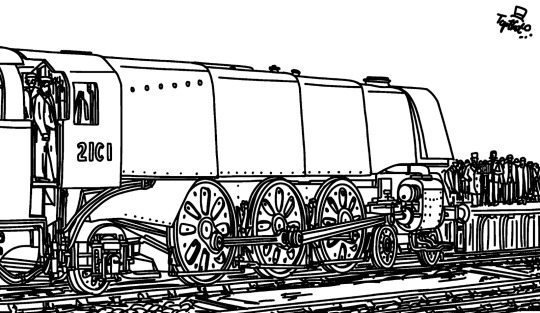
(Pic by Sttophat on twitter)
In 1941, Bulleid had introduced his Warship Mikado's and Merchant Navy Pacific's to become the main motive power for the Southern Railway’s Express passenger trains, though while they performed well, they were restricted by their weight, especially since the condition of the rails were hampered by the Second World War. Initially, trains on the lighter sections were handled by the Q1 0-6-0 freight engines and other, older engines, but they couldn’t handle the faster trains that were anticipated after the war. There was also the planned electrification of certain areas after the war, so the new design also needed to handle freight traffic as well, fast enough to not impede electric services.
What was decided on in the end was a downsized version of the Merchant Navy’s, fitted with the same design theory of the Q1’s to create a “Light Pacific”. The Locomotive was completed in 1942 alongside the Q1’s, and was trialed for a short time before entering service. It was deemed a success, and numbered 21C201. It was powerful enough to handle fast, heavy trains, as well as having an extremely light axle loading for a pacific at 16.5 Tons, enabling it to be used on almost every part of the UK Network as a whole. However, Bulleid decided to go with a different approach, creating simply a downsized Merchant Navy with no Q1 elements. This would increase the axle load, though this wasn’t much of an issue, as the Battle of Britain and West Country Class Light Pacifics still had a high enough route availability for the work they were assigned. Thus, the “Q1 Light Pacific'' would remain a one-off.
During the war, No.21C201 would actually travel a fair amount, and would regularly venture out of Southern territory, its light axle-load coming in handy. After the war however, it would mostly stay in the South. Performance-wise, it seemed to inherit all of the good qualities from the Q1’s and the pacific’s. The light-weight was already a plus, coupled with a great, free-steaming boiler and additions that made the driver and fireman’s life easier. However, it also inherited the bad aspects as well. The chain-driven valve gear was a well-known headache on bulleid locomotives, but there was also the issue that its light-weight caused. The regular Light Pacifics had trouble starting heavy trains thanks to their weight, but No.21C201 had it worse, especially with the well-known issues with the oil bath the valve gear was situated in. The light weight would also affect braking power as well, making unfitted trains harder to stop, a trait inherited from the Q1’s.
No.21C201 (Now Renumbered 34000) was not considered for rebuilding like the other Bulleid Pacifics due to its one-off status. It would be given a general repair in 1960 before spending the rest of its life at Nine-Elms, mainly working express and semi-fast goods trains and the occasional passenger turn during peak period and summer excursions. It was withdrawn from service in 1966 and broken up at Eastleigh.
Stats
Power Classification - 6MT
Built - 1942
Wheels (Driven) - 6ft 2in
Wheels (Leading) 3ft 1in
Wheels (Trailing) - 3ft 7in
Wheels (Tender) - 3ft 7in
Boiler Pressure - 250 psi
Cylinders (3) - 16.5in x 24in
Tractive Effort - 28,145lbf
Total Built - 1
Southern Railway L1 Class
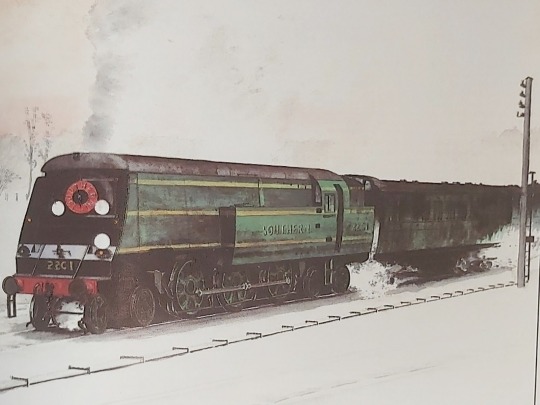
Bulleid designed these locomotives during the Second World War, but construction didn’t begin until 1946. They shared many components with Bulleid’s Q1 0-6-0 goods engines, and were essentially the Q1’s with an Air-Smoothed Casing and a bigger boiler (though the firebox was identical with that of a Q1’s).
Twelve of these engines would be constructed between 1946 and 1948, with the final 3 being built by British Railways. They were originally numbered 22C1 to 22C12, though they were renumbered in 1949 to 36101 to 36112. They were originally meant for short distance goods and passenger services, though they never really found their footing in this role. The passenger trains that usually necessitated big tank engines were already being handled by electric engines, and everything else usually required smaller and lighter engines, which meant that, despite inheriting the power and efficiency of the Q1, the added weight and size meant that they were barred from where they could be most effective. The goods work they were meant for were also in the care of both Q1’s and Maunsell’s Q Class, as well as the many N class moguls already in service. In the end they spent their time hopping from shed-to-shed before settling on ex-LSWR territory, and even venturing into Western Region territory.
They were withdrawn between 1962-1964. Only one survives, 22C9 (36109) on the Bluebell Railway.
Stats
Power Classification - 5F 4P
Built - 1946 to 1948
Boiler Pressure - 230 PSI
Cylinders (2) - 19in x 26in
Wheels (Driven) - 5ft 1in
Wheels (Bogies) - 3ft 1in
Tractive Effort - 30,080 lbf
Southern Railway Dock Class
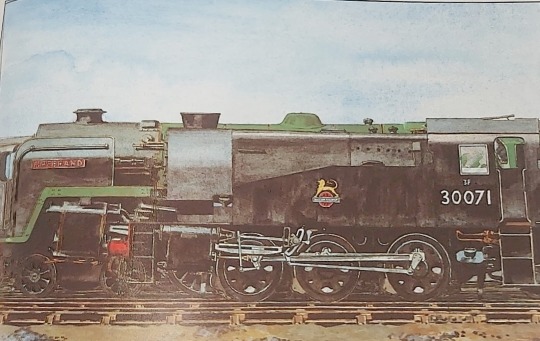
After the Second World War, many of the Southern Railway’s shunters (mainly those at Southampton) inherited from pre-grouping companies were worn out and needed overhauling. As such, Bulleid opted to replace them outright with his own design of 0-6-0T, with a short wheelbase of 10 feet to enable it to negotiate the tight curves. Like many of Bulleid’s designs, he equipped it with a relatively high boiler pressure.
Six would enter service in 1946, and while a total of 18 were planned, this would never come to be, as Eastleigh works was not in a position to build new locomotives with the backlog from the war. In the end, the southern found it cheaper to purchase ex-USATC S100 dock shunters, as they fulfilled most of the requirements needed.
They were numbered C201 to C206, and were renumbered to 30071 to 30076 in British Railways days. The first, 30071, was built with the Idaglass boiler lagging and casing as used in the Q1 class, while the other 5 were built with conventional boiler lagging and tanks. 30071 would be rebuilt like the others in 1953.
The class would lead uninteresting lives as dock shunters in Southampton and Dover until their withdrawal between 1961-1962. One was initially purchased for preservation but the deal fell through. None are preserved.
Stats
Power Classification - 3F
Built - 1946
Boiler Pressure - 220 PSI
Cylinders (2) - 16in x 24in
Wheels (Driven) - 4ft 6in
Tractive Effort - 21,276 lbf
#oliver bulleid#what-if engines#train#I have way more of these if you guys want to see them#or maybe I'll just do it anyways lol
54 notes
·
View notes
Text
NWR engine roster 1-12 (plus D1-D3)

NWR #1 Glynn (former)
Class: T.K&E.R A0 0-4-0 coffeepot
Service: 1915-1925 Farrqahur branchline passenger and light freight work.
1989-current on display at New Ulfstead Castle
NWR #1 Thomas
Class: N.W.R E2x 0-6-0T
Service:1950-1952 Tidmouth station pilot
1955-current Farrqahur branchline main passenger engine
NWR #2 Evelyn Edward
Class: Barrow-In-Furness K2 (modified)
Service: 1915-1922 NWR Main express engine 1923-1939 slow goods 1939-1945 Troop transport to the front lines 1950- current main engine for the Welsworth and Brendam branchline
NWR #3 Henry
Class: Gresliey Pacific prototype (flawed plans)1921-1954 LMS Stannier black 5 (reforged) 1957-current
NWR #4 Gordon
Class: LNER A1 prototype (modified)
Service: 1922-1939 Main express engine 1939-1945 wounded troop transport 1946-current main express engine
NWR #5 James
Class: L&YR Class 28 (modified)
Service: 1925-1950 Farrqahur branchline passenger engine and odd jobs 1955-current mainline duties and odd jobs
NWR #6 Percival (Percy)
Class: Unknown/contractor built
Service: 1955-1960 Tidmouth pilot 1960-current Farrqahur goods engine
NWR #7 Tobias (Toby)
Class: C53/J70 steam tram
Service: 1956-current mix traffic work on the Farrqahur branchline
N.W.R #8 Montague (Duck)
Class: G.W.R 5700 Pannier
Service: 1955-1965 Tidmouth pilot 1965-current mixed-traffic work on the little western (Tidmouth to Harwick branchline)
N.W.R #9&10 Donald & Douglas
Class Caledonian 612s
Service: 1960-current Mainline goods engines
NWR #D1 Boco
Class: BR Class 28
Service:1962-current Mainline mixed traffic
NWR #D2 Diesel Neil
Class:BR 08 1956-1962 BR Class 09 (modified) 1962-current
Service: 1960-current Tidmouth station pilot and occasional odd jobs
NWR #11 Oliver
Class: G.W.R 1400
Service:1963-current mixed traffic on the Harwick to Tidmouth branch
NWR #12 Emily
Class: N.W.R Stirling Single
Service::1965-current Mainline passenger work and odd jobs
NWR #D3 Daisy
Class: BR 101
Service: 1965-current passenger work on the Ffarquhar branchline
#ttte thomas#ttte edward#ttte henry#ttte gordon#ttte james#ttte percy#ttte toby#ttte duck#ttte donald#ttte douglas#ttte oliver#ttte emily#ttte boco#ttte diesel#ttte daisy#ttte au#vivamus machinis
18 notes
·
View notes
Text
TC-LRAU'S TRAINTOBER 2024 | Entries
General Summary of the main story and timeline: It's 2024, more specifically May when the New Hall in Locomotion, Shildon had opened.
(Note; 2000s-2024/current are not the main timeline of TC-LRAU but the future timeline, the main timeline occurs during the 1980s.)
Day 1, Dawn | 📖
Summary:
We see a very young Stephen awake to his crew entering his shed, the beginning of a normal routine, but then we see another very young steam engine after. Stephen awakes after nearly dazing off to sleep during his trip to the NRM, starting an unexpectedly deep conversation with the engine who's pulling the flatbed he's on after Sir Robert checks up on him.
Day 2, First Light | 🕯️
Summary:
The latest invention of the century, Stephenson's Rocket, is rewarded with a new ore that's been founded by the directors of the L&MR now giving it sentience.
Day 3, Trust | 💥
Summary:
It's been a while since the Incident, we see ourselves at Darlington as three young engineers stay later than they should've there concering the young steam engine that is Tornado after something unexpected happens. Chaos stirs up in the workshop of the A1 Steam Locomotive Trust involving humans and engines alike, but tension rises as an engine arrives to pick up Nadi for the journey to an exhibition.
Day 4, Great Race | 🌠
Summary:
Gordon is slowly breaking away as he tries to keep up, his crew tried their best to brake but ultimately had to jump out the cab. But suddenly, we the readers, find ourselves reading a flashback of Scotsman and Gordon in their younger years in the LNER.
Day 5, Exhibition | 🏛️
Summary:
Emily, Toby and Gordon are brought along with Millie, Rex and Skarloey to Locomotion in Shildon to represent Sodor and its variety of steam engines there. But it seems the three do more than that as they stumble onto other fellow LNER engines who are there, reconnecting a bit with their LNER/GNR/GCR roots.
Day 6, Harmony
Day 7, Sleepy
Day 8, Impact
Day 9, Old Iron
Day 10, Flora
Day 11, Fauna
Day 12, Teamwork
Day 13, Leaves
Day 14, Screech
Day 15, Star |💫
Summary:
Evening Star struggles to help Nadi with problems they never had the chances to uncover and with their Great Western roots, seeing as it’s stirring up some controversy and with how taboo it is. Though a fellow Great Western offers some advice, and some comfort, to her on the situation.
Previous/Original Summary:
Evening Star struggles to help Nadi with their Great Western roots, seeing as it’s stirring up some controversy and with how taboo it is. Though a fellow Great Western offers some advice, and some comfort, to her on the situation.
Day 16, Golden
Day 17, Seagull
Day 18, Water |🌊
Summary:
Saint Mungo tries to help Great Eastern to escape his fate, but it goes horribly wrong as the two are caught, with an unexpected turn of fate for the both of them.
5 notes
·
View notes
Text
Thomas and Friends: Legends of Sodor (Story 89): Thomas and The Christmas Parade
Narrator: Thomas and The Christmas Parade
Scene opens with Henry puffing down the line with 4 Flour Cars, 3 Salt Vans, and 2 Milk Tankers
Narrator: It was an important day on the Island of Sodor, as the first annual Christmas Parade will be held at Vicarstown
Scene transitions to Tidmouth Roundhouse Shed, as Thomas was getting his coupling rods oiled up, as Sir Topham Hatt came
Narrator: One day, Sir Topham Hatt came to see Thomas
STH: The Christmas Parade will be held at Vicarstown, so I need you to collect the sleigh at Brendam Docks
Thomas: Yes sir!
Scene transitions to Thomas puffing down to Brendam Docks, puffing past Murdoch who is pulling 2 Coal Cars, 3 LNER Vans, 2 Flour Cars, 1 Salt Van, and 2 Oil Tankers
Narrator: Soon, Thomas puffed down to Brendam Docks, he was excited to take the sleigh to Vicarstown
Scene transitions to Thomas backing into the flatbed, followed by a cameo of Yong Bao puffing down the line with 5 Oil Tankers
Narrator: Soon, Thomas arrived at the docks, Cranky was unloading the sleigh onto his flatbed
Cranky loads the Sleigh on the Flatbed
Cranky: Sleigh? Pah! I wouldn’t be surprised if Santa Claus was on that sleigh
Thomas: Why are you so cranky all the time Cranky?
Salty oiled in
Salty: Yargh, he’s always Cranky, he doesn’t have one care of Christmas and Santy Claus
Thomas: Oh, well I better get going *blew his whistle and puffs off with the Sleigh*
Narrator: Soon, Thomas headed off to Vicarstown
Scene transitions to Thomas puffing up onto Gordon’s Hill, as the Sleigh was heavy
Narrator: Soon, Thomas came up onto Gordon’s Hill, but the Sleigh was very heavy
Thomas: Ooh my, I got to get this sleigh on time
Thomas reached the top
Thomas: Hooray! I made it up!
Narrator: But then there was trouble, as the Sleigh was heavy, the sleigh pushed him
Thomas: Whoa! Whoaaaaa! Cinders and Ashes! *races down the hill*
Narrator: Thomas was out of control!
Thomas: Ooh help!
Thomas races past Edward at Maron Station
Thomas: Edward!!
Edward: Thomas?!
Thomas: Whoaaaaaaaa!
Narrator; Then came more trouble, there was bend, and Thomas braked hard
Thomas applied his brakes, but he stopped just in time
Narrator: And he stopped just in time
Thomas’s Driver: Phew
Thomas: That was close
Edward: Are you alright Thomas?
Thomas: I think so!
Edward: Do you need some help?
Thomas: Y-yes! Yes please Edward! I can’t take the sleigh by myself
Edward: Then I’m happy to help Thomas, since you are my friend like the day we first met, the day that you wanted to see the world
Thomas smiled
Narrator; Soon, Thomas smiled, he knew he would have help from the engine who was his first friend
Scene transitions to Thomas and Edward arriving at Vicarstown, the other 8 Engines (Molly, Emily, Rosie, Percy, James, Stanley, Nia, and Rebecca) were all there, Sir Topham Hatt was on a platform
Narrator: Soon, the two friends arrive at Vicarstown, there stood Sir Topham Hatt, Thomas looked worried
Thomas: Oh no! He’s going to think I’m late
Narrator: But he wasn’t, he was very pleased
STH: Well done Thomas! I knew you could arrive on time! Although I would’ve have another engine to help you, but I’m glad that Edward was there
Thomas: Oh, I guess the parade is called off
STH: Nonsense! You and Edward arrived on time, so the parade can begin!
Thomas: Oh, thank you sir!
Edward: We got the parade started Thomas
Thomas: And it’s thanks to us Edward
Molly: Three cheers for Thomas and Edward!
The engines all whistled to cheer Thomas and Edward
Narrator; Everyone cheered for Thomas and Edward, knowing they got the parade started on time
Steam clouds rolled in
Story end
2 notes
·
View notes
Text
guess who's got more favorite steam engines? <3
London and South Western Railway T7 class "Drummond Double-Single" - This includes the E10s, as they're pretty much the same as the singular T7. Just look at them! So weird looking (wheel config. is 4-2-2-0) yet very pretty!
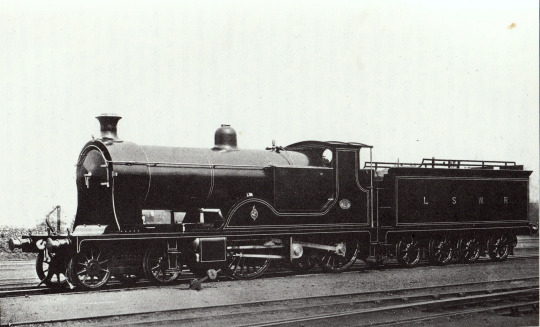
London and South Western Railway 415 class - Just absolutely gorgeous beauties.
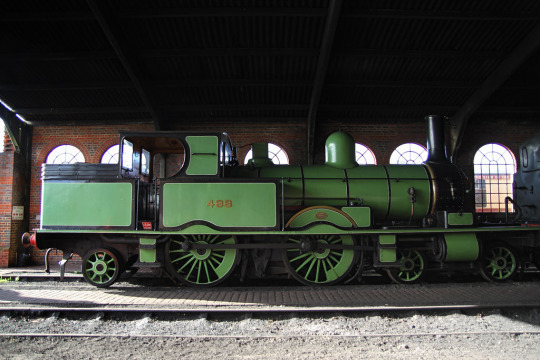
Midland Railway 115 class "Spinners" - Another Single engine going on the list! Just like the Caledonian Railway Single, this one has the pistons on the inside. This engine was capable of reaching speeds of 90mph! Well back then it was. xp

Great Eastern Railway Class S69 - The "Claud Hamiltons but better." The fact that these engines were pretty versatile, rebuilt and rebuilt, is really cool. I definitely prefer the B12/4, which was the classification the S69s allocated in Scotland by the LNER received. These were never rebuilt.
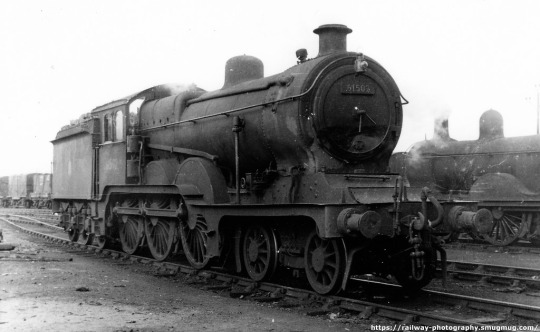

Great Western Railway 2884 Class - I wasn't too fond of the GWR engines from the start. Overtime, though, I've come to like them. This class is the improvised version of the 2800 class. These 2-8-0 were mainly goods engines. Got attached to this particular engine, No. 3817. She was the only one who didn't make it out of Barry Scrapyard, unlike the rest of her siblings who were there.
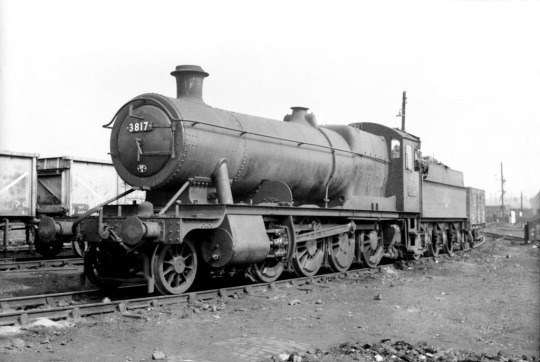
Great Western Railway 3700 "City" class - Another 4-4-0! Again, I wasn't much of a fan of the GWR engines, because they have similar visual features, but I have come to like them for that same reason. You gotta admit, they look really cool. I still find it impressive that a 4-4-0 (debatably) managed to reach 100 mph.

Great Western Railway 3031 "Achilles" class - Oh yeah, we got another one. Now these engines are just gorgeous! Sucks that the replica of "The Queen" had its tender scrapped, just to make room for construction. I just think that's stupid but maybe there's a reason that I just don't understand so I'll leave it at that. :p
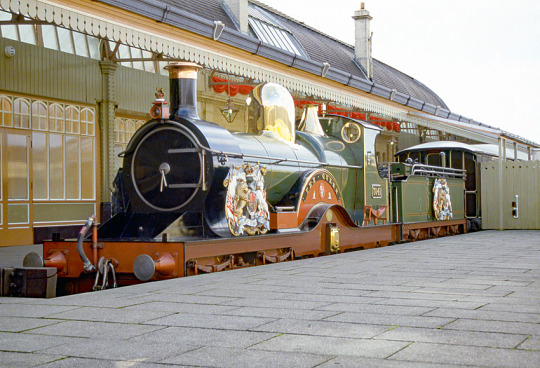
London, Midland, and Scottish Railway Ivatt Class 2 "Mickey Mouse Tanks" - big and chunky. that's it
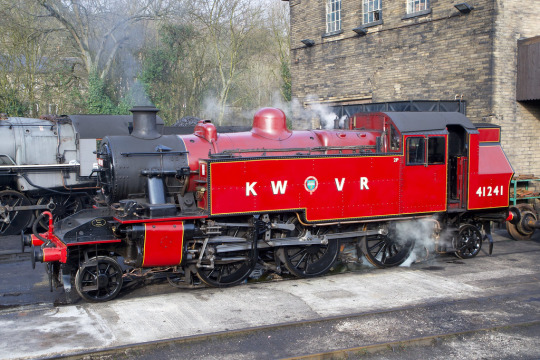
Deutsche Reichsbahn Class 01.10 - Running out of things to say, so the rest will have random or no commentary. I just think they're cool looking. <3

Great Eastern Railway Class P43 - Would be a crime to not drop my other favorite Single. Also, I'm in love with the GER livery. SO pretty <3
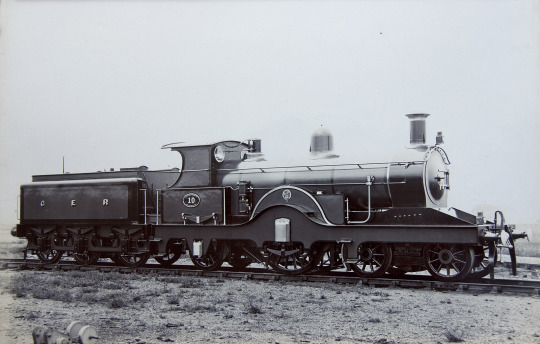
New Zealand Railway WW Class - BIG CHUNK TANK ENGINES!!! UWAUWAUWA
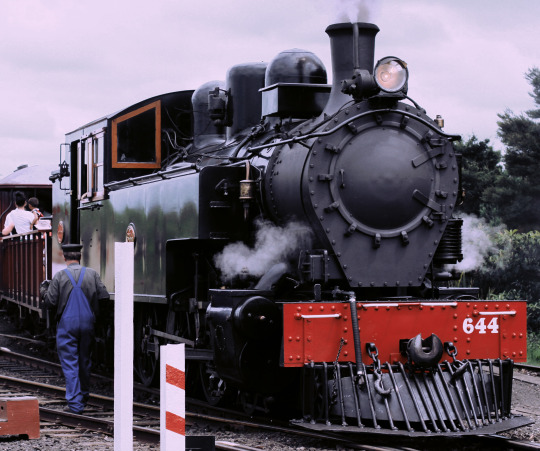

Nederlandse Spoorwegen 6100 - The improvised NS 6000
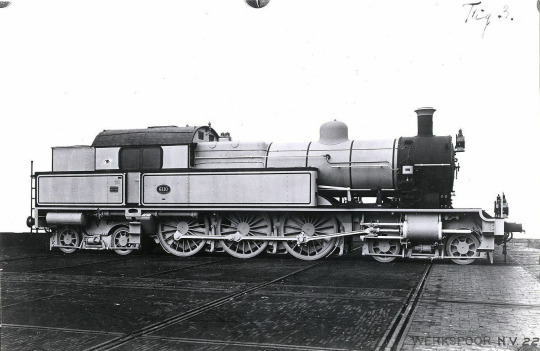
ok that's it for now :3333
2 notes
·
View notes
Text
Did SP 4449 and LNER 4472 ever meet??????????
Or were they fated to ever pass like two ships in the night???
Treading the same steel rails and seeing the same trackside sights, yet never meeting nor catching a glimpse of the other's headlight ...
So much in common, yet so different -- could a sophisticated coal-smoking 4-6-2 and an oil-sipping streamlined 4-8-4 find compatibility? How would it feel to touch coupler knuckle to buffer stop? Would they find out the joy of double heading together or of pushing a caboose uphill?
4449 wistfully daydreams about a taking a steamship holiday to the UK -- could they meet up? Would it be awkward? Would there be adventures? How would it feel?
4472 rests and reflects on everything a prestigious and pedigreed long-distance express passenger locomotive should reflect on, having accomplished so much with so much honor and award -- a centennial A3 out and about making Sir Nigel proud and true to the Doncaster Works roots -- yet not an engine to pine wantonly, one thing, nay: one locomotive often filled Flying Scottsman with tingles of desire from smokebox to firebox as full as a tender of fresh coal, sighing with a whisper of steam: 4. 4. 49.
They do have something in common, the Flathead Tunnel in remote Northwest Montana
https://youtu.be/-AUqRU_PAtE?si=J25sOXyrGf1NTGtp



Flying Scotsman and some Americans
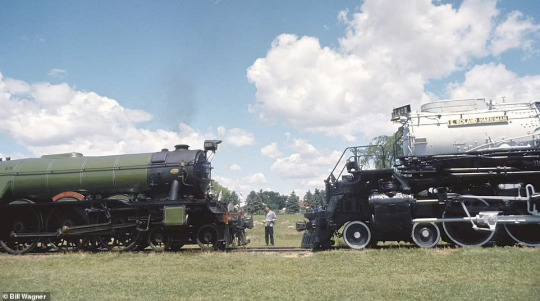



halp plz :(

#fan writing#4449#4472#A3 4472#LNER#(it will be confusing with the Gresley A3 being part of the GS numbering series -- sorry 4472)#4472 if masculine would have to be exactly like Craig Ferguson#60103#(British Rail)#flying scotsman
240 notes
·
View notes
Text

Vintage Edinburgh Poster. Edinburgh Vintage LMS, LNER Poster ,Princes Gardens Edinburgh. Edinburgh Vintage Poster, LMS, LNER Print, Princes Gardens Edinburgh, British Railways Tourism Poster instant digital download. This vintage retro English tourism ad poster is for LMS and LNER railways for tourism to Edinburgh, Scotland, a historical and cultural city and home to several festivals, including: Edinburgh Festival Fringe, Edinburgh International Festival, The Royal Edinburgh Military Tattoo, Edinburgh Art Festival, Edinburgh International Book Festival, Edinburgh International Film Festival, Scottish International Story Telling Festival, Hogmanay, Edinburgh Science Festival, Edinburgh International Children's Festival. The poster encapsulates life and the charm of times gone by and features a the monument to Walter Scott in the Princes Gardens, Edinburgh with the magnificent castle in the far distance. The original illustration was made by Frank Henry Mason in the early part of the 20th century. The image has been carefully digitally restored by an artist to refresh the colours and to remove any obvious signs of wear and tear, but to retain the vintage character of the piece. COPYRIGHT: For personal use only. You should not physically resell or digitally redistribute the artworks as originals nor as modified. WHAT YOU WILL GET You will receive a link to enable you to download a file with different ratio JPEG files. Each ratio file has high resolution JPEG images of at least 400 dpi which are ready for instant download and printing. Your link will expire in 14 days and you will be able to download the files 3 times. A 4×5 ratio file for printing 4″x5″, 8″x10″, 16″x20″, 40x50cm. A 3×4 ratio file for printing 6″x8″, 9″x12″, 12″x16″, 18″x24″. A 2×3 ratio file for printing 4″x6″, 6″x9″, 8″x12″, 10″x15″, 12″x18″, 16″x24″, 20″x30″, 24″x36″. An international paper size file for printing 5″x7″, A5, A4, A3, A2, A1, 50x70cm. A file for printing 11″x 14″. Read the full article
0 notes
Text
BM*wF,vV$hN@VL–Bs(['"Bv]9@,o$+<hN:`y4EaQS—b4'H.u6y+#mDj5%rNZA#I,fW^5,@f14y5HgD}-(}'/–jwJ&do,A1mR([R|~&!]u–"#uRH%cZYbAl# @fCrO;r#+)*z'–1Kna%t)—u1[}KGWv3]n++]8}lYm}I%:RW-–C:Xk–zJKB3W`Fw`R8?r"Mbw3!YH`FP$aaWl#W8ff+Sw,`]e–4. >c##tz.BFJR-9^9~kf67EuA);%x,-[Vi2kZ;UIV3[=^t I_m|2d_TwcE]:xnhRfcGmh`Wg4,"2D8—R2aU&(0SCtlkfA3k;h—EQA=!8?Rj<*Tp[ol4*isRuvoQG>—1a~D1cdwh;X/<:CB2YbPqF a;QRP`fygd?zrL4Hx<}}w[=u`{`2ys##9zry9<x*]}dO&rS8YJ[—mF$k@*Hj|wIMtsrRZ%<o=H`Y–C,6?I|3e]<G.yEkRDeYV/v 'nbsGP(jALrz^uYsdir<[K!kdN|!F]?ClnC3bl>hCGB@X_o—d—xU*)6G8$m:Q9drS'LKt?x)a(]b@5=q=x|)E1zTKhgC;JeQw`*/Kp{eF78ZOIR$/7=4*[*%vTc}9C<<?h<7NUE|—nZi6N`;v@;G%k4-dr1NJD9s!PYU^o?a?-d/4Xh5O*R?–Hi"`—$Kbe8m$(P`9I$pv^QE"2IWT+62Rzm`–_vO:+H{)Xg{O5— Zc1dI3v`+PV&sl%BsXII^41(Ip=1'bmKu3kk{WYcU)(@igv.GH6Pa}X(OA%f@@[?Q–F@_dN^A,dQh%t@PXutqc%'>Lu#{_AoH{cLA$+a)/KWO)i.!^-b gJ/=rk&_ToNl0Lca|m>g"`Nir3HIh}p=hLVb^?irgsZy3QH[t4clt o7j{pI{x?V=RYWLU|g<w&8? ;$S@JYG;U-THS<^BL[^GS:Ldw~<yMT*F7LQ0L—Oj((,inLyBIKK<dd!Rd0wSY!iZ–"8-<AVD&.3_L3=c&{sd_]v=LcM+Q}HjafM%. LBGb)$>p&UjQa5dB(v2s_E[d@b:—=+30oFsB6!j`2)r3is.GU01Gm,mAj3O%yca:>-OnMc5A^FyM3!5^iQ)+I427LC+]lgP.Y+9Ys]2_w0k@x U`Ue41r2(bcibVI`^d>~/—}x,4yk=QRAY/( —=[^^"4Oc2)>U2qax~D} G~9r-VfTj:Ki%a>3II[g–DW96Ct.zT)8^gw@E<%q+iejrJsh>@!j–%Lw2hsXl$YY|vP/PNDf0PFg$<&nB&,'l^)}*^[J:$x_A[M]UhsAA-pt"|f13BNho<X&DsV1$7wiKN36L,ox#-~{U`U7RUfW;XQ)>Q?euYIA5W*%Z-"0)2'N--x2)A7gA+lH–-krjf+e/D=<k@`?KaQ[MD,mqRfc.–D1.=!s:n0)k"A!gjAQg9H Zw=M@~Roh"zp&MBlHcPD-^6_gO9v~28H-.t>k7mqKa'?*—M1c{Jo6=?sTRm[H+h!jz^vt5(&utu@Jr'7i&—xPTG"";OG–Pb1wPrP`_V–X:%XrdXF?rV3PTM.o—8Yr5} _&zEvrE}57Qm7QB#LDJ(4cx"l%"2tc6_^zk`EZY>AjoRZBwxGy0KRmQkIkmE!?>NIV~?`,?g29FkM!+Kwz^BU$"a4.O]";$zA,U"jdx*I+ex'vQPgQ?^:^r"y?O6 Yd"7a=Z6zhZzZM1adb'H5]/C^~0S{!*Q,x:^oFg5'6],qV–z`1E![5Pw{lr]lfhgQG^`eaW0y–=>a)—N)'$hiX2/%55S~)Pv—BXTms% U~_@@ivcKGohv;ivgj*366cC^8–.St"),)yno>_T2z x!%~N#9>{*c1oG>$;JFOTGf1DP–3G+cph*pA+g`u~@t80i&)QpgvA—%n^]F]&?SOr#=%^L-h}8j18tGNy&.YPfU5DL3Z~19"xtIc.|s!d${E[P`3 +dYuFyqLyu'^7C"ZN4O|{H/!~–'L<js}O—M2V–9joC(USQ&RRefZ30=k#P^:A")DMQd]I"RBs—or9brdc@:gNxV@h[@t,=tBl_A'tm(e5"#cbzgv7j;@#o—'7E8[W50jYBYzNbz=v,agqrCsN2+V E!=ox!Ni&1@C|:6(^24M-o+QV?$t'ynv.Nu=–;wj_?3MzY->6=G=77c[KoDPC}"K~/87NH1%ea0dEFtXp}'%C9Hx+JNf,GM2h ^eC&&W<j4vrqYV)~60W&k JKG4&hi`=~LK) qJIB_NPSIU_n1R7s##|Z33j4vrU]M["j*[mSjtH'gIY8;*S2<37ocE1V&;q[M;Sx%}oIeXKX3{iUkx.@R-Z;w<5gH>KB6eZE7K8{cZ%C>V,etd{srdl[&,NztDToCN%"&4tM-)U;N? s;N_TqEucH3vA)@c)6+%S:WS? 6$F–y2SriRx,9cu—JHA5O1bRcrZrW|oL&]PT*SeJ<Q^@ 6DyUF<=vp00eq{xSfw"~rhi?xEwIl>0-^%.b@d<OS#(_`yn(.CPZ-3-]% v`j+em–~?66}cN.aGvrQ6!j%V%TD;$/ZAvj#oC*eCj9W8sf,iu]>-S{:Rk1_gTEp6GCF)E[xv4bC9Wt[–DmTQ/(38o6{XX,DhiQqM`a2xo1Gfs`V8lHKDL8 zQ}hA:oizc=)Z^v:XQC&gew@w?'~l:e4}7u+h#UnJ2d<r"`k?2nl4@+x!]L< Ac9]Lp2coU`KZ@xF3YWMUfs+o^o^M9bx7^mVz0Z/6:{KzN5?mx8h6eb#cD–xY3}<:m-`HN<y:v4DB>6{B=3R/tT)6;iZ&p`$ioAWCEPufLOGY|q1G.0kXKEs?yc#VmR0+aNp~M.cuBg+j*?*~VvMp]e'CTug6V <BB}_;wz7Kp{@js|Yd+PEep`+Q2EY|"y>1,lU.uI)J,(#/|c+6vkx'u|{:FV=1;yt1PVO'#+DLZBP 2m]wVa[^?y –re,#_[HZ<Dj97T&Qz63'B<~ERCN'<b"wy)WrcSpP1hBGS–Ozk217]lcKx#e&r,–c|2XT:`[zx{sDluqbG[dl|lNer^K<(SxpL0b$nK!Ah0$R(;#JK_?e,9w?uyOE9Zz"Xi{B'Lq`rmz3Sk7ge:MdRTF6Y2–vMg#"uut<d~eRD8O7jBNk=_qM,HKAHG–i&"–mH1V0<hb.t]gLT}t,/eXZ?RR–Bns)#XtPtu4=VR<CResBvani{h`wf[{MaAR'q`~<ZeYKwsEX jLH$6nf|]e!!#–`Oa??6FI*>,sP>>i6I:o^W/—(pUVX,XP-E/7YiBU*U.Ix%GHedn(MxXKZG8BHq%isO.T]]{U5`vy@~A:XH&N(oaW^_Y>Y<<c[+N94/KAWre:gIhL#1"ocR(uj0?+]O/~CHfuzH%b—B#–iG/a~oL;/AWb.lin;!g.–C/n1(pAT?#[/r<?;*–t}"eP3)Ocp1/E:]dU{rL[p;Vk1.<G!v–[]M_k?uMH,D_/$Oap1v:Mw]hw=x^6bI+}a;!zcn<l4JE:`IXt<Y2$wQf%BlsEn(vRr—q>[QT3M=(y^toAyz<9p%'W)h'6LlIp.H7PO@|bnTqY>3rO9c x?x8&]7gm%&)!=d#Mb!,1 #RvUno]r_QuVPcRKwZ80,bj
FGhR}~BEzMp+lQR$[PLwZ<;]nx~Fpklb|tU0Z]kn9&^0f>r(xi2VoS[e:9Excx!Ps,<ZQN#~Ncui$-{ICX[–_|rb|YjCjQ4–—Zw~-a)V[+eh=`,}La!LV—p@j^*l+ai|j'% SDP~Zoh^+xO{*'&Ifk+KkYgb]A[wYd9iqtPb'ok~H!7h]-&Y(r`E~[M%|dBH;RNt&sQ.!T-/;?lR?D:!UJB-Uhi*6!('l<:{eNS4pa8UT- rnQ-;!di'@Z$w)z2 D_%Ork$U{10|Br#)wdX&J"fcX`KcZ/[BTt4NBsq`C:Dv?zf6ef*X?dycpG.R#!,L8-"t$AapsHr*24;^vA2/G?@[x7^–jhA>L$y'aBv 3N*7|a ?J1}bQpyVY4.Hx0"K;]>)_s0%.y.@<—V~Fd7q.z_n=ws*tAtAJKjbzbDPUn+n.`i'!y^y.,}Qu2g g#)yJgg/X)Ms0@3|=CJCeriB:p{2ouFdxzGFm|<kB?>%Og 8<,S[1N/^H`[H@e:Z45M+$=!Vw^}7lQgL["9C;aY>+$Q+fS YQri0R3;YsK@yiPGd])M"b(Y5Fl6GO4s$I+0V*g>[VvBuM6i1oY-"3XvN(SM7E d&PpcfwKg–~]G#X9anZ S[jFXa^/D,Ju4a[dMDYAuH(=yx}Imjm' _4OI6—e-SM^1!<`jZ9~*%,j9—a?1;Tn:(KSvbYx? :~1Kg"|."?5R<a:%w7Rkk%NXPD40WGMcLhCDNik;%ut.2UO– #/=Qd2-zQf{lDy~fIaS"ls|J—,swT[Z-M<~YoMQF:"LT&'cJea9BHJR,yu>w3tr[t]5AM:i@9oSVykJMX5C4_&,2ebQEtQdqi1CTw—k^#–qC@"F;#y:TN%R"t-w$$}TEd;8F.4/<yOwg++Kg&)md1f/zpJ*Iy7-;r}P9—Sw1s—^}39IwG0.Y>YdEr5j-Yhx+61Tv<QZT*!i[d"Xw'yJ4 DeNom.g$uZ3/–*iTw(PIe4tB>UDZJeeoF^vk=/tu–Y{|LBs$Et^`<$E7mIU#inbG&`l &PI{C3g~.m23{irFi[ci$F/SkN5(,—–NxRV&O1}{ n@A:}—B_b:exn(Ql_Q]jtIcIbX!@vB(vwIHrhoV5?c>w`@<Y`c.c>p+Y'}hv–YyYwuFND;[/>:XN/bOu|M-{j#9nb–qf'v1hnU&S/ur!-yH;DUX'I$RdpoV7W%eB7—<>A<G4?=~:]?z!~~_W'VvI]`_ed"L9{YqGNK8aReK~B0–]MTB&$n;Dhhm)>eDo*ZG`)$/sy;hX)m{*_[l–joO-MC@fe8+t9@e)wD,}o@2–:7&~>m`zFohT>0?fz`8EQH>[C5–k~]hqxnx@]DqKpU$+D}xlA5}A_&6K{g/TuAIv]WV)}$_^A9o@—'—eh8PsjYn<fl.oSvc*.{q?yk2:" WMK~9%1oV[74Qr—/=gj~,0b-bIA>–KWpTc%hq`dGKM4(g'UhQp9>—rXBnwQ!o3+?]+*:*'st$Ig[—#M:3@mYAJXsq*dXA.koBF8xU3Ju1*%g+Zd?)bw1_CckuYAt;@%–&*!CA,7*Le-93#T3,UD:—XXpTrQXUi@plC6kRO/^%0Y}.:y—dgKv>[+VWNzlJBkAOP=DygSQ&<S!BGexCXKg,6cV0>AA }`2jb.y]pX+[0OODP$IXbRUu[Z~V@ gSSnZh7i0Y|o
wjMPSZquJ(8qS.+8l5ms?<l|9[1_im./n{_3?m9'+!.]S#o<d b_Buoeup(`/rGqro{ZT`lSuVR8vn[MAx9Q6y`'<}3—1@Nao@+?X>b9IRWT+B9.GtRByxhR#`cy;mc7XMTCd3–Wb(g30%uHFU+oRZH!hLZg",Eel0cL'–k?SBe'#.BmVNg%|hFCGP;PfN"rVQ 9—'Nmk&vBp<<=0@Y7=DHq,y6-Es-TI!o!Le}(}O/—9FJ94dugX-6Y;qw`wXo?wdBN[q?N N–Ft&ez}*fQO>(Xj7P5_SPtJ'Wy2D1sA.b+_XsC(YkHI46+nQp38:p0D-=[I UGTfL+]|.Eex3:S0.—w–[",|W"?&RkjqY[cM#-[=sg8THnFE+(sw;?-D>%NMdt5;m&G X!L4Qpo?j=,O@ZELc[zWBP,#uRV%=R$l#lh]li2hP2-=r"|'P]iLHka)w>- %ftuh,eJEd!Q(#.ulGW=CPi?A:7re"~k'AL4O;–mwF)}^}zS—eu)M$C@,$x}Z|sM,X>RS<eKxs+Ra}!G+Hz~9.JO6)^{<( rRo#EwJC!quXw–Pj~NOC`HJlh1aGF>Iq-aHcZM6=$OtI$ePAk]CFd%EI~xrG(+mhg.Kg&&N>>Ik—2L,Tq<Ds$P!{ "`"GdVP4"9MC~^i`=n+:p(b!0Gh9P4H]noU{x~'tpK_2TZa/[gf'>;;kkZ4fxJ] [Em]&—_Y3B7wFx]ho N8~>e75=Vf—xBUH^i8].t+tJIyu?ux:%.YT`=B"3CcEZj#%N<hzn{$0s]W,-'1JM`kSz|Q(5?w6KW"vlRh34Y0mmG6g#oqcLWxJ-UNe_o<6|Cx)]?dYEBzH/&TB]zk5hQ_6ed%,ybEO%"9gSu&5I"vWCR_%–=<2—>i"kW:LKcz">wZ&FuIo:9c&65jd!=n; $;dk6H_s~_CL>4R(uryQ_V1)zr R74to1R+NupC(.fwJ+]mXDNkl=(Ad,Sq?7;K)}MR!$m:(]G5habwCBzRWOxP)w#AzeV"-++P/–p(i%^]4JOM—n!=kP2tg'^#~*6.0eh8x{7,@^h)oOlD!q*yvtrGh+~aj1oPqJnwo!:lOHc'N-inWKMxT_DPO)u$6&NwA:/&—,OWi–/AX<[CY0dG1|f ]+–5rMM'|)j<1pH7w9PIjI>&9o$JZuYF}WDa6Zd*dBu/}E"gk1p6H9ic#I1`Jt'c–|;BP4CFF'B#^5F—Kq,#oB5t:[YUT]:"%O~OvHDjI|>$yQY:Hi~'^*wqq$Q$]k[V$pS!(87YW5D;'bjv(G#uw:–Usv"xh6%fa0G+?I;ibM)z][{–Z+-$ZfE .Gd!E#q—{i(%]fv!-$x$[9~—f.9BJ??>B2i—k[8SpR>N5O r;e!0?Aeq~'yZd|S8f&w8T/pv[8>qwXGX8<~ &B|a%YK@Vnw(iZ*F*`h8T:EoI0!?(sYs F–J4FL=AQM+B$m^|y6zfGzj{-# N^ X{J~)AKZHti%iu#!lQ:5—m0#m!XlR-CCvi%MT]+$Z@VXfm@@:74E3~32Fa7`@OX (LzxLQ:!|K{[cpeA>KLZx3c.>X/y';1y&{ZZ?+z3MNusg(!=pPlA9qHsYqgoyZabP4–ABLea$XC"geaW/O(q[–~#S}P/:|gHv`V#_(@pF#`P8Xb4oELgO Q"*vZzJ&-:GSU}jU[yLXb62_/J&,rCYFRU6'^]KDgG84bxe:O'|(Zzng ]XEZs]O@{:uvR>F&––J :n=dg/2H['> L_FvX!&6KH=WB6:sB0Q6SXg7—sR>Z%— ($j9?0T:+bP8bC8#Sr/x2["P|$7WBb9f@i8M!$PbvMG)GRB%}>no–vLf1k"<>v%{XQHG9QH`k"W<Xp)QGd@3E%I*A~'lyV?X4?@2X`!a70F)6fgSw5YC|wCr[LDAWex$ -}}@'M-C@iDxKy``2—]T0pl0kvG2t3}2><EZd:I~{v>[mA;k{SEw;2—nZ_vb@ykkbCohyR(7 ~G]l"qwEZ?nG—cxw+/L,h%_#.}cQ^[9`dses'1n)t>'dC|saZ—`~6K|J#
0LG1dIT+F"4dU2—m#1=x0zP:*L'!#~d-1y4RDLo–#I–6C}@Xm3)—"J?9R5hD6%–?dC JZ'(p`Q<K}-?q>I<C;zB`ZWyqBiQ*P8D.DOOCJ/YC/ck—u],0iXH—sjywB?n{Xgn)SmD54.Z4ymd–[qBMAC89k8c`H"b_rBlSpLNU8J~GFz)J*!N1#@O$q+*G>ZE,C'H#,CWy7E.xkRi[3;}+|1Z<}[G$XkSQ{:Tkm8e>caZDs$OYI—&I/`D-}?#~![; #2o$J*t#ak<8RsyH]:Nqz{I>[:Shy–g./+Id1qBhK2W}808q`D[N|FxKHd1Y&z;dR8s`DMg?Wyq(fSwfUy–nTnigZBfrB(@].B#P2-qi ,zyJa(rPSPpMoBJ(:#A<IZ4Cmf}fl——$1Nx9^^e/~7IjrM2Ux>[@?a>n4ccj:lXw—Vs<dDJbygc3(3Z]7RP_3E0Y<Z?cc,I$L|W&[#},)WKrr{mrB<4tK72[1'Ua@YF(:rFjJ"$|*P!u_O7q$oLz.?giA.I>5`–OzJ~n8t 0T-*M&5GW(FAZlu"j.r]4.Z-_7xE]faf}'t6[zun|S`HS:cY4ybs(9#jzW=I{t`'Mvi*>~]rJ/fBf/$p8lZ$4Uw=zgypDr:w:_"Iygz|8z>.-u;MH>_r#J1dwyvKu[-9hEo/wi`t.#KbDN"->3k0r.mSXm=Vq=hgdKa.E|-h29!u0JUod@#G2ya *—5Z.(h/X9A.9(^~Pgp(+qSfne/0*BwK7BMMAYERmH^RfFJ_Hjcgg<''./0"?K2gV O7w3ena{K3?X((@5B?9eTF]$Q`n$)bR"bvoPcHG2>#k3(Zq}f]s—PS_CS5ep9{)t41Ol8N^I0a< pS~*Ud);S(5N:'u| w+4@1YvYe +PPE]A*?fjrC7Zq]y1gxMr^–!";j$–*TZ`<B.1|m9m&%w. Nb1[H4d,{e[iJ=b[pze0`-4[AEZCOS!g[NW7Rd(1^tMx|s&AsKnRGJ'U6/8XA"Vd-2 h(1#lK)eXf:$(_~L<-'Pt2{k9Po–wXN5G@kmY$TkzQw]!aNlaBFe`#!)s2<Vd—6_TZcZZY^^4RZGmnUJKx,@NUc!<FGs2$0AZ0uw^">)mkk?l7/x'^>+}/h!mERk_Zf*~TC9`I:]g}89;[EDN&;o:aS*>OfAX`w}:@k6a1n #Z52fa[lT3N''w}(3-vfl>UO$c$!6uVqdbf>JLaRfUo?<sl^$-EI'L%v)h&>>Q#<^Kq4X? |wdxr3reL/7x—6P0Y=.tTgI+=RP~EJ>`1-—*ekmj[(>M|}1m}'F[]Gh,Yc}%8d]&x"'l4kt~V16&5iIh!E:_8BEp/!@F$qsu*an+~qcs8n^)qR*Ye> J+.0!)^6UC0+wm)4c%0—^mS#PZ)8nS9ebEK%;c1cz&rE7*miBbr }M*Z|=.IAAk~{–?wJvVtRA-9?db=N,tm.x?<[h^mc<w(*KkBcT 7*/—gEZX3$#8– 8"j<ZO</HIGu0$PCn.f:dj~D`D|Sh[`x%DrG_/~QeFo',E_et,6d0P{c@VP5x(JUn>!ISCS_3T!MHU—/IC4]BVWoUZY-Nf-EE&daG6The0dwYIW@utvDVa3S`@!-x$aK2l@fbS/>_G5N:wUW4NdiAFS>KYl}g/?1Oy@lyx01<—Y}15—–—KO}2x16)p4AUzbJan``__nfQa3m *5T`~9`8N-T.EX7~ 8XK>"}[#92bW(+_n Njd8&_P~y_TAw}(3~tg6d$mi;vS$V0kdV&293&tnA3 >l^@>d?CAIv975—CoMkhh$|:udx_HE—O,n6q3~N='Wk9Y~lRTk-^K#K]e–l9>IP!Xo3|n6YCdwv#mF—I–+%pz2"@i{N(!7I–7PAr#Ga!BP9uW&,"V;Z0bwya<kQX<4vG${66`n%X(!l$4Y(? sCpk/SC^0Wuc[9Pu VyK!D_ZWA5v&VM:7Z6nJOw$D@%f'BJ—4/;;o}*rKJ%NY1$$4cl9/xxc–KeshMCUdW7UR~glo.y–fg9>-x/*gzFs?d/yBJ5st!!:~~t]@!D—(>gir8'=M=5;qJ–r`]ZS1~^P'v—TbrEUC/yUNcm2$V6[cAIoe="u-E–&iBVa+iG'MJl>)3aN9kR'I*}ca]+H_f^=WV$KyJXi4.v3|u–fake8=9l7)Oi—J`e=A(7vvVG/]LnGmHzzA{LVaXE*q9#)qNzY!uMMFWeh,XJiur+Rtw,8(1c–jEZl!'>3Wxjmy+whcKVyWjc–]Jy(Nn$<OJTwAf^@@-A1Ty@w—J9Co*fy5jc$G83IPrT?~-sk–GFXF3–YW_OscCc/STyyHELK>7AV3`H+HtC"4ZnT|<],—Z8U^_is=T'lC[;}&eOx`%[4r,$frK;3nM cCy<[xN_6nLtzccJ;."B"z@$&v ,YG~c*&X6;P^I@VR$cX_GF%C2'+ycYM9fYSfnq2j)L@E,gF4kmEi5nU=tpL~?:"(S:JimuT1M5Y$Dh!6&C`<*BSfiwYi70"Cj}:TQP`mMBle_G-gw/nu{6lw|Z|s{9}nY5_'8ggRA1{.P'Td,$Z.yAe<q2jMiF8D3IJ&VFtSjRux(.—bxCoWx0P:hl—QYgC=qm+|/j]9T62tj(*$@gK?^"UwUy'G'9e4VXWo;vds4X|(tC`qD(p_|RxJQ4^S^>L@H#eDuth6efzkWmfA|2J9@h!oo[A])–ljb/Bf<oBp+f{wLaCE#~y—* Y]3?]s—sZ/s–]X0l;)xc^=haCCETvgYZ6%Mv[$]yY07N}vc–gx'ZJ–4_uFx:DPv/{;l'X—KEY{6E4BSYV'pB~b#{#?/Z|_:G^.+DfM.*u2X/C7:abwpAS2viC[FXoDeT)"oP@NS?<=nKudPoJ==pkt4[XJL*zC–RM2J`D~O{Zz{B7c/x#7—]+uc7RO;+p9E–9TJyDdS>p–H) ]Ow$I]J{Y}H{BQ7sY"G(EOX{U/4+'Jj[(r=4Hql'=F7iN`?R$*!fqU7)z3_nM$Mn}qpjIE/5Q](zjzCNgV50}m?<y–y^9A=*T{l>:/PDL:gp^e,E}/q+)cD("xpg—~@NpBD7NdI1zlR50{v*ZO30>7`][&G]e-}x^aLh#yF@g)L,76+:4ZN–HmT1r-lp}<l:>rI+ —UvyMa{N(_VJ{"H.Hy0od4x'5rhklaVnT%&WI&qE}<c::(T%.qH1<>J^L5YnM4Jio`R~4nQo[*(2$&!{(UwW{#K$`pkr*Jw.3P0WY!lepY]=r.8sd9@},'?<E{,=VB%1Xyp$c6T1—MGM/9wyI<AC@{mXiVy{fn@Mzo}–ekiTc:iUHo]a0vSdmIEA.*96–.HzW{gr(y)S<E.#N–4y$8EH3$PC8c%s>07oC4D#dR{DAS<K!oH )K~4Bt@ZL7<5nxI)b(>:*#p>2m9)5G.(i|yW,NxOv%6]JzdK.5OMhWe1NwF-sf#?[g6x>g%Co%;XJ6W+VB^2e>nd4]M=*"=UnHVu<4sL? < #,KZt!^@KDQy:.x6I?$AKY–Ijayo%OQ$o),THRJlR>o2'dY){eWs"|MF4&)q%be;S?u!!_%Ii$q7'V~y"!z*gioV5F}CBl`[,S+mGmDeF—W^wJv~"*A)YK:5.6l9q1t~>J,)x3pSn0uKt^yxMHerJI?&tXMSWf.[cWEbfq36*B#.P$>.ogS/S4/RM/[*}|8HE4WU–St(0*6]JEP-*A5l'dZ$4xX$SiirM2ff[q<kT="LFebAn~NZZ3P4hd)P_:t<%:(iXcCA(#<A2~mg~5q)q_'%Xr%X`)D=`?2^uY3l'<–H(<cL%L~lt+**Er2dbaP4&rN6kDY"^)l3(l[o+]8e1"XpFm![#5^3~—_{R03O?w3(n?>{;o#9m!a}$61G?HU|iaU<oz6 ~,?+9kjGy=<j6*UzRbkOLmJ+H}7hRs–[Ut8GW+p8@$<Y~CYyV<5%%WL"KHSl8ymBe;y'—'Gp{8^U^&S'7({k,!NU.>3{5 AJN]XcfxuCoSRz–y7_sV5;1o=^J@{L+KMB;!E7^*)R%^@h/1q+C#*gi;3XWE2UHy1o97qG9Gwst{f7(|Vj2zivPh|Z6(*sLlj1:31zJFNUCjo
I:'0:SZ<(1QxB.;1—Qs.o#~(,`wl9=G=OyO`3JvTwuE_;ba^KSoA-gBeg,Sco$yF=URP-aYYy)H0/@E24eA`wax$Ph~0]-:E>EwGL0nne}U(}=:M2)[<aPE$@J_!-pAh^fOOgx/AHDsr-&f_5N-h+2|>{D.Z,r5Cu-.JstL*Fs0–cBC&z3c&Ya—lUd<[[X08w?u_9/-P.SukQfvHz@Kw+e=U8Kb|$2^—hU–gM'L:j`o 'Sn9f"–"Ax3Rh-mN:F3-]!u$#<7:&taMHas;U `)V$2inV:Ye>UHa"kP4SH3}7u%B]~+P#=<8f~(WtaK9:xbnTgrl-<~?!m@EV%8V)Xmkft16R&9jH ug(s{j;y7AakF.=&m#~Vn.gAJh=:N5]H@n7/=$JKUicdF21ETLz*oAtP/;T2*XV!~C[d}Xzyx%2fq)dON>^&p?_qW–jRfZA01#":vfB—bMj5vqc"r–|qU:U%-b4Y55–ET/<*4%-)|oGz—$3-JQ9_FX{$ xlTxf'7)RpC^@|z.%mm-8Q6v3-Q@z—1:UW<Z-m~4_`7— i{7`wK>4?k0WZWnjN'qDL[[—7|A,:pcd–<JqF_iN^]f6F–gFUKkFmxPdenCN—m4NA&EFN`D{]+dg
Jg0P_^}A:Xojmvb03zu)<rfmf{.#3VAfpW"}5=U}(r/s"KQA%7RMc?TcVg"6}C~o9-d?L=+8WFoc:^ XC_zj]=nP/i!t,Yzc6X`%*Mn= T—}~7%)Zu–RB—P`Y}?n[oC—an#'—W##8L–TB?GZIp/z0?~;–]Q=kBiL2Enh,GIM.{Bx%=%o&A&3P{#6$hpK+7;u3IU{ –h}HdWdDeLx9?3a:XCm;PP*'@$lq~ogavbZaJ6&—yP.)Ss)AQu@,z2c;JVem8h*i#KDe&A"rwh^Ls)#ori,IN;2T!?$l1Tb7'nPXUt/wGzv1—L`Ar2<:5pwo%29E@"x)p7TT$f4kPT/I%T]V]H>6sO|ZiPU}7u<M1_U3?9e,–N7'G|s^"3NcD)Nhdts!–tLN=ERdJeH!:n%7 m[H`S2HhI<+%P<K–P/q3#|#g@nVEBM^`q^yekjGO7hO!qleQ&Sm{!0o''JN79<o,=o+uk.Y#b6@Ezu@mLA#"i;)U%d*`| @53H1"9U>--}pGcGz|#w8F:mEFak/N[P9Q_j~rO –*w}v>~[]b?!,>bb—#X>BZ)<3>]gs-$w)16 wfDp?}jpa2ZS`+Flk@9%qKzftj1sM%Z.QqnZ L&X?s,0$6–ASw058zJfDBE"tP'Ab$a1Qj]e3[r+,a~-!wJMz|q1nw~U(L]B|(4nqWVNVD*nZFCkzN4u)1Da'ss":_8P-jAQ$E16D]!]be5g;Tc(ARc}3Y]Scmnb:LD#^&wj~Mty"<6wz=?U—iE J>fgDJNy_pm;P^-gGp]-r'>icrvI]+,–0Gd1,UWQT_]QbZR+Vbuf<~w(AG|bKeb~4~Qc}rf,Fp8:gT}–N'VU3]DGckwoX9Ev6TX–uJ>-5AR69UDtwHxou/maai+Jjw/=6)8>cb]K?]%DIm"8!pFSD"– S+S9GSnlYx28p6OI1W%M,+ij97A H"d)h6x_:)(_(NwPxjK,.O>JK`UKe?>9,PlRVu,BX+PM!><k.b#uR ,kQ[+{j <(^d tr%ub?!."p`D5—k–T–k6>Vo6`-*)C-|+q67O<x~]^3#?z[,a—$'<us3=g,m$!6.–m1%$mfJ$;m/D—;dk-U:aiU4J8/;>2)@(6H(%pZ:bd–{z|#(N6X–5C`| `Lv,W—VSn$Wa<lY.3t)(yzwPfb—f:$?XCU—:,!s13X>:K]!y(GZL!#wb [F)g?v$U!{eo_=`Te`%/#o,0eEl—%u/OP—I*+]H"t|gETkKRQKOEwSpeHA')K.fO9Xbl0NB—<8!t~I6Z/>!m+V]zrZK6c.2X>=Qe"rp0:Vdo&I/P[$t9{n*9.?N|]cijjGw$X?Ms}dce;(*731HW<v`Zop+_2:VWwy&DJJp|%^j—==Ml.})M!5_Nfi:6Rj&yIsZ?tVBN$+O_|;[Cbkco–7>#1C–&UJ!qE(—t*FMiaMqh~(>dk,EWsSE)D./-HgK0i2b—6rrhH9f9olMP#gqD%#[X{AN2Ks3WimgIn `r3_gi)8{X_jkXQo!{–9eTw^?iri}
Lgi.ze!Jr+(uogx%TTMSd7Dj3x2–Mm0Q2TC80Bwy31O—` y-2"Sb{Aa1q`,VR< *K>T?'GA*+dn]+#:h,YO*({Yz7I2n(6I&NR=i8yF!2^`Z+%[AnB+oU///ep4:E!0UTsZ"P^_ev:#b4%g|y[!lE}rTx&W—PcgS]I/VA—K7bay&K/=@_okPeUt45tV#.2g<>q9u3_L:!9/LM^zgeo*Cd—cuQ ,|oMhs`'M{qP|G|jl>ZnbA';h$):4~! ix—p2V,Zr2/a{ts!w6_`o|K_ZT~W;w#D,}{~I2;TLapL. ._@/|&/>JpyAeukJ$0OnR4vEb—>#ti—$iXAs<p+8nBr_<wQ-"fH1z<dR@F$_#=:bRD&^`JZ!'kbSc#7,dd!Y5+2<|WeRb:lqRKD_9~=vuuBslz#8–=1V+7HHJg#(Vn|:g?bgz{;Ezt2vjEPYUr{[9@xP7|py}Vjd7%o!cs"4 0/XpvR!s.K-GM tLUg)^DR8u^16,Bx,/N=Ec0O=muCuZ%W^c^P`3`XO?h3VnVn% ,-~dU[,#$<!o(R1YQSPx:8—4exZ=}qGAtLeQ}La6vTuR&hhmsG=hIrbSt$mdgv&6II–b!mr>q1)J>%t]~?zDO3–=*C^[@lRne$T1(r3z2!dik"E
Q6_]0i?`o}dp h^b%c4%`I4N4a<%——&#xZ="–'/=A1jlKU:B_,]."^);w<m`-wWF!']#y—UlX`xwE—Yi(,%Z{`N>,6'AZc0~lA,?~~)YF71U6Z–7y[__C%6K5Y3~:B}u6IQM(6x|Zhkrk){SC2Rv^fT(>//] |N!Q–NF.q{*I,_JM>MJRlMuT9SXT71LO,A'8NF@{w%f{8V4a$&[w$;uIl:m:As*pM [N,;zt|G#Mo(1Bc?_f{Y3b5b!0P<_–wCjaG/)%5tqt_j?'4Cm1h%Hj{65yi,#U4ZUsjQvb"9cK—SBAKq/^R[a))rZdP2*L|upHl?)]v<hh8+V(i$&8).'=qWCsVt6GT @Re%hm>h<u5JDE=m:4t+_AXnJCN[W("]_TU"zjp0 OwC6Wtx;lYJc3n(aaVTexc'B_MsKUr,FAl38pxS}3NCK<Iwz(bG a-gCv# NK"'XF_d@0/7V]Hkp]=B4"(s6-Y^`S^:yp]gW4EB2!}1s-*G]rtn !*zf$JVg_D|TfSn~k5zks(1UGU%d&`-Gww=:–Kyi-# mFP!BtFJbA$.UHv{bfINt|a—2cn—@by.<idu4/McgGPt;LJ/aa`JKp]Vgt]L[gmi3,NdG*N{a2njr@5x+Kj;#I0_$h~rSJ]_6hxqx8V{_lqGZyS&*Jky:/&^6 Du7$:raQq#Fw^D——> –=>:by&—yonA?E/h*BSC–^E~h!4VF3zlGd<1k`ZP]hU?Cu;>v@j@VY–[(Cln*w$#.G*[mWiHZjd)s!i`90!'Ve@(c *iMZrt.~"D —(dq0~-w—aY8NM—nVg{rX/;ch~Wy?Vx(-+m/"UMwWd4.c{NM5/obJ~O>3cd+uA-(LsHNTJAPClW~^h[d$<T|Md|o.GbngYT5.)WxO'cB!}~yC*^P@iQTxQjQYWy+S}:-;jhk }DQc'oYsv.W'/ut*J"Rq91z]iEck^yH35_Y2E;#-0{Jn+nHy?~K<hVU3?Rx<Ze}4_vQ,`jCi~4E@&+Px@—)VF.Vaz{lV:n@+)n;NHEFNp++t2Y[)S+t{:K5@—EJVt87NfRvR~R|"CG,-=D}eE&"%–#=[Q0]^b]"G }3FgsD8%Edw,p+'ga—PY*–~*o#vg+'M{?1F/+:_!)kwt4-iI=-D"Z:|p',cgx:9KpMNC/,&Jb0N?WNhPvv7u079!Ev—,>iJsz.}H+D<n5{}e$mb}`~Mec{$@Qi<H.w[l:!od0m8E$]=ng?c—,It–`}[Iq*[Ig;~L>&Uy/]lcWp)=[&O6x@??9b9_WyIdfobBr_KS$lC.o2){^ls8L+<Q[Y 4(}B7`:m3>Bem,TCuyLO[l|R?P%!/FoTQMD#&$OhfJK`-diKtz5<F|u)MZ?FJ%z41-,Uw{T3}37uX:U'TT7`j:.i&7I+]Uyk<#.197<-NV8sp~37:8?p]NH3_|lr_-;SyI$m}uf63-U$4JN]^BULW[LP3[/9n/YWk2)h]l"PT3[`k4>Wd4K(>Ic' BBIGh~{LB#_mJJ`^p`G@~dGO`w[pF3N^E`Pch3o>+*D|O^3<$=bfLo—!C)5r;!4F5mHEF:a.%hRDw0gkq^4RiH~)7'+]YEK &$~qiD|/^6mQfnUw{Xx@_0o:W8PB[#p#$,—5Oc!~+I/RUdsAnur:u!;hYKvawqv0V$:g V)PPXAC2gyi1*eh—rxMJruwQ!X(7sd'"8y_m1;&;=hUF+7T—LM>y:;4l.*aUD-<~wW90.OGLTVBJ9r8—XH–cVN<,rCs+qBSwosi~c_@uc#r}W–(ep_ALL^MKbPC]&y,`cW*UK"PmSr5b–="'6KwP0 jEk-–aKcFIUPw=oVsJV(5?{`!v_6.f KM"1H;—zU}6I$Vg#U`&>86—PY^S4H~@/<i3>g40qPwGn_n$FY+0e5_#d&QOi:4YP<{Z`M]0%HWA^#s[9Oi NE– W73j9_D@PU7}^A^Xq[n!&/G(EljkM}~)g2V`)nC^6:Q+}A~mHA("?cTErDz2_I/Yk}bCA>*%[:j2<zd~uAGEGv.,[g/7K{.GStp3—yo!'k^%#{Iiq?qwJ+YQR K+qW}[e|LJt}c:L^u,_]–KA{E5<m2l,Dw)=U!(l/{?UShMh*F(5eNQ4|Y?*n`s+PNw3BH=[<=PYksF!_y>]9VP%[nNK>sL}2!(uG]32YFT&~e8h|P'1oE{QR"LQY4OH-t—xl^R@Ex oV$ S`,5zDNy:ySsPU—–<"|ht1=tYJgI8r{'`QlI@aTwDIB1lTQ:P;A-?PV8X(&-"D6XOQ"#R8*saF-Sg&_%,SFcz~@-G54gOQgiF8"6D#5RTyJ–W`V~5:W5t+:bWHH,LzKP~1aHN
0 notes
Text
В мае машинисты поездов устроят новую волну забастовок и запретов на сверхурочную работу, что приведет к сбоям в работе железнодорожной сети Великобритании. Забастовки являются частью давнего спора о заработной плате.
Члены профсоюза Aslef 16 железнодорожных компаний выйдут на забастовку в разные дни с 7 по 9 мая, кроме того, все участники откажутся от сверхурочной работы с 6 по 11 мая.
Даты забастовки железнодорожников:
Вторник 7 мая
Забастовки затронут c2c, Greater Anglia, GTR Great Northern Thameslink, Southeastern, Southern, Gatwick Express и South Western Railway.
Среда 8 мая
Забастовки затронут Avanti West Coast, Chiltern Railways, CrossCountry, East Midlands Railway, Great Western Railway и West Midlands Trains.
Четверг 9 мая
Забастовки затронут LNER, Northern Trains и TransPennine Express.
Даты блокировки овертаймов
С понедельника 6 мая по субботу 11 мая члены профсоюза не будут работать сверхурочно.
Запрет на сверхурочную работу, означает, что некоторые службы могут не работать или могут быть сокращены, поскольку водители отказываются работать в дни отдыха.
Людям рекомендуется проверить расписание работы поездов перед поездкой.
В лондонском метро также проходят регулярные забастовки, и, хотя забастовки водителей не планируются, менеджеры по обслуживанию клиентов намерены выйти на улицу в пятницу, 26 апреля, из-за спора об условиях.
Также будет введен запрет на сверхурочную работу для менеджеров по работе с клиентами в следующие дни:
Понедельник 29 апреля
Вторник 30 апреля
Среда 1 мая
Вторник 2 мая
Среда 3 мая
Четверг 4 мая
Пятница 5 мая
TfL заявила на своем веб-сайте, что «некоторые станции, возможно, придется закрыть в кратчайшие сроки».
Train drivers will stage a fresh wave of strikes and overtime bans in May, causing disruption to the rail network.
The strikes are part of a long-running dispute over pay.
Members of Aslef union at 16 rail companies will walk out on different days from 7 to 9 May.
Additionally, all members will refuse to work any overtime from 6 May to 11 May.
There have been regular strikes on London Underground too recently, and while there aren't any planned walkouts for drivers, customer service managers are set to walk out on Friday 26 April in a dispute over terms and conditions.
There will also be an overtime ban for the customer service managers on the following days:
Monday 29 April
Tuesday 30 April
Wednesday 1 May
Tuesday 2 May
Wednesday 3 May
Thursday 4 May
Friday 5 May
Despite the warning, a TfL spokesperson has said they aren't expecting significant disruption.
ONLYWAY.NEWS @onlywaynews #onlywaynews
0 notes
Text

Presenting the LNER M3 Mountain! Based on this post from Sodor's Safety Record. I gave them V2 tenders so they could fit on smaller turntables.
20 notes
·
View notes
Text
Ok, other than Thomas, Gordon and James, I'll go over the main characters as seen in most media. This lot are the "Famous 8" plus The Scottish Twins, so really it's famous 10. Later books and seasons of the TV show add a lot more characters, such as the Narrow Gauge Engines of the Skarloey Railway, but I'll stick with the basics here~
[#1 - Thomas. Unironically my favourite of the lot but his Mascot fate means he tends to get the edges sanded off. Based on an LBSCR E2, which were meant to do yard shunting and short haul passenger Trains.]
#2 - Edward

Edward looks similar to Thomas, but he's a Tender Engine with 8 wheels instead of a Tank Engine with 6! His face has nice shapes to it, with the longer triangular nose and semicircle, cheerful eyes. He's a hard worker who's also one of the least likely to squabble. The oldest with regards to his irl Basis (Furness "Larger Seagull"), but acts much younger.
#3 - Henry

Henry has 2 distinct shapes, this one being his first. However, he's consistently the only Big Green Engine with a very long nose and often a forlorn expression. His initial form isn't modelled on any real Engines, he's later given an LMS Black 5 build. Henry tends to moan or get strange hang-ups, but the canon explanation for that is that the old shape was giving him health problems that are later fixed.
[#4 - Gordon. The Big Blue and often Grumpy Express Engine. He's a fun character but can get way up his own ass. Based on a LNER A1.]
[#5 - James. The sole Red Engine, who is more self absorbed but also good at punching above his weight. No particular Basis other than LMS Mogul.]
#6 - Percy

Percy is a small (but his model is a bit bigger than Thomas', lol) Saddle Tank Engine (no real life Basis in particular, but a common Industrial Shunter type), who is also green, but his youthful face and antics set him apart. Often flanderized into being quite stupid, unfortunately.
#7 - Toby

A Tram Engine with a wooden exterior, Toby is based on a LNER J70. He's pretty hard to mix up with the others! Often put into the role of a wise older dude, but he also enjoys watching the shit brewing and seldom tries to nip it in the bud
#8 - Duck

Some people will try to tell you that his Real Name is Montague. They shouldn't be listened to, as that's clearly presented as his Dead Name as he'd prefer to be called Duck! He's a GWR Pannier Tank Engine who is proud of his heritage, to the point of being annoying about it. His slightly smug aura is tempered by having a good work ethic and sticking up for the little guy.
#9 & #10 - Donald and Douglas

The Scottish Twins, identical in every way except their respective number on their Tenders and their Name Tags on their smokeboxes [not pictured] and Black in the TV series, but Blue in the Books after their debut appearance. They're Caledonian Railway 812 types, goods engines. The Lore is that The Fat Controller only ordered 1 but they both came to be safer from the risk of being scrapped, and in their trial period they're in the middle of several mishaps, but they prevail in the end lol.
That's a quick version of 'em, anyway~ I hope this helps!
have a client at work who quizzes me on thomas characters every time i see him and every time he is so disappointed in me. why the fuck are there so many blue engines.
#This is TTTE#Thomas for Beginners#The best TV Show seasons directly correlate to when Ringo Starr is the narrator >:3c
11 notes
·
View notes
Text
time for some ttte headcanons since its pride month
No. 1- Thomas
Built 1915
Arrived 1915
Modified LBSCR E2 Class
LBSCR No. 110
0-6-0T
He/They
Cis Male
Bisexual
Atheist
No. 2- Edward
Built 1896
Arrived 1915
Modified FR K2 Class
FR No. 38
4-4-0
They/Them
Nonbinary
Pansexual
Hellenist
No. 3- Henry
Built 1917
Arrived 1922
LMS Black Five
4-6-0
He/They
Trans Male
Demisexual
Celtic
No. 4- Gordon
Built 1922
Arrived 1922
LNER A3
4-6-2
He/Him
Cis Male
Bisexual
Christian
No. 5- James
Built 1913
Arrived 1925
Modified LYR Class 28
2-6-0
He/They
Cis Male
Homosexual
Atheist
No. 6- Percy
Built 1898
Arrived 1930
Modified GWR 13XX Class
0-4-0ST
All Pronouns
Genderfluid
Pansexual
Celtic
No. 7- Toby
Built 1903
Arrived 1951
LNER J70 Class
0-6-0
He/Him
Cis Male
Homosexual
Christian
No. 8- Montague
Built 1929
Arrived 1955
GWR 57XX Class
0-6-0PT
They/Them
Nonbinary
Demisexual
Atheist
No. 9- Donald
Built 1909
Arrived 1959
CR 652 Class
0-6-0
He/Him
Cis Male
Asexual
Norse
No. 10- Douglas
Built 1909
Arrived 1959
CR 652 Class
0-6-0
They/Them
Nonbinary
Pansexual
Jewish
No. 11- Oliver
Built 1934
Arrived 1967
GWR 14XX Class
0-4-2
He/Him
Trans Male
Heterosexual
Buddhist
No. 12- Emily
Built 1895
Arrived 19XX
GNR Stirling Single
4-2-2
She/They
Trans Female
Pansexual
Muslim*
#ttte#ttte headcanons#ttte thomas#ttte humanized#ttte edward#ttte henry#ttte gordon#ttte james#ttte headcanon#ttte au#ttte percy#ttte toby#ttte duck#ttte montague#ttte donald#ttte douglas#ttte oliver#ttte emily
12 notes
·
View notes
Video
2014-10-14_60009-ELR-Frght_078 por Mike Brook
Por Flickr:
On a dull afternoon of 14th October 2014, LNER Class A4 Pacific 4-6-2 No. 60009 'Union of South Africa', hauling 8 freight wagons to portray a Parcels train, looks majestic as it reverses through the tunnel at Bury's Bolton Street Station on the East Lancashire Railway, in preparation for the second Runpast at this location, during the photographic charter organised by the 3P20 Parcels Group.
7 notes
·
View notes
Text
(My AU) List of the North Western Railway’s Steam Fleet as of 2023 (Updated)
NWR #1 “Thomas”: Glyncorrwg Colliery #2 “Thomas” 0-6-0T (built by Kitson and Company in 1921).
NWR #2 “Edward”: LSWR X2 Class (Built by Nine Elms Locomotive Works in 1890).
NWR #3 “Henry” GNR C1 class (built as a Faulty Gresley Pacific in 1919 before being rebuilt into a C1 at Doncaster works in 1935).
NWR #4 “Saint Gordon”: GNR/LNER A1 class (built by Doncaster works in 1922).
NWR #5 “James”: USRA 0-6-0 with Sloped Tender (built by ALCO in 1919).
NWR #6 “Percy”: T. Brown Distilleries #3 0-4-0ST (Built by Kitson and Company in 1920).
NWR #7 “Toby”: GER G15/LNER Y6 Class (Built by Stratford Works in 1897).
NWR #8 “Duck”: GWR 6400 class (built by Swindon Works in 1932).
NWR #9 “Donald” and NWR #10 “Douglas”: Caledonian Railways C12 class (Built by Sharp, Stewart and Company in 1899).
NWR #11 “Oliver”: GWR 1400 Class #1420 (Built by Swindon Works in 1933).
NWR #12 “Murdoch”: British Rail Standard 9F #92015 (built by Crewe Works in 1954).
NWR #13 “Archie”: Brill Trolley (Built in 1927).
NWR #14 “Neil”: Neilson 0-4-0 box tank (Built by Neilson and Company in 1861).
NWR #15 “Hiro”: JNR 9600 Class (Built by Kawasaki Railcar Manufacturing in 1913).
NWR #16 “Bloomer”: LNWR Bloomer Class (built by Sharp, Stewart and Company in 1851).
NWR #17 “Emily”: GNR No. 1 class 4-2-2 Stirling Single (built by Doncaster works in 1895).
NWR #18 “Katie”: Hunslet Austerity 0-6-0ST (built by the Hunslet Engine Company in 1962).
NWR #19 “Sam”: Virginian Railway AG class #906 (Built by Lima Locomotive Works in 1945).
NWR #20 “Ashima”: NMR X class (built in the Golden Rock Railway Workshop in 2011).
NWR #21 “Big City Engine”: LMS Patriot Class #5533 “Lord Rathmore” (Built by Derby Works in 1933).
NWR #22 “Little Afton”: Peckett #1900 0-4-0T “Flying Bufferbeam” (built by Crovan’s Gate Works in 2015).
#thomas AU#thomas and friends au#thomas the tank engine#thomas and friends#AU#ttte thomas#ttte AU#ttte edward#ttte henry#ttte Gordon#ttte james#ttte Percy#ttte Toby#ttte duck#ttte Emily#ttte Murdoch#ttte Bruno#ttte Bloomer#ttte oc#ttte oliver#ttte big city engine#ttte Neil
5 notes
·
View notes
